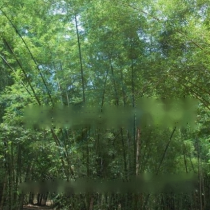
Chinese name: Xiaoyelongzhu
Latin name: D.barbatus Hsueh et DZLi
Alternative name: Buried mulberry
Family: Wo Undergraduate
Genus: Paeonia
1. Morphological characteristics of the small-leaved dragon bamboo
The small-leaved dragon bamboo pole is cylindrical and erect, up to 20 meters high, and the tail tip is curved Sagging, base with living roots, rods with slightly convex nodes, dark green at the bottom of internodes, apex covered with white powder when young, rod rings hardly raised, with a ring of white villi below the scabbard ring. There are branches in the middle and upper parts, the sheath falls off when mature, the inner side of the leather is smooth, yellow-brown when young, and the back is covered with small brown bristles. The auricles are connected to the base of the scallops in a wavy shape, with irregular tooth fissures at the apex, the blade lanceolate, the apex acuminate or acuminate, the base wedge-shaped, the margins with small short spines throughout, and the middle rib obvious. Flowering branches are leafless and grooved, densely yellow-brown tomentose, with no fruit seen. Flowering June-October.
2. Habits of the small-leaf dragon bamboo
The small-leaf dragon bamboo is often distributed in the area of 360-1100 meters above sea level, prefers a growing environment with sufficient light and shade, and has strong adaptability to soil , The soil requirements are not strict, but the shady soil and sandy loam soil with gentle slope, deep and fertile soil layer, loose and breathable, and well-drained are preferred. The dry temperature season is not obvious, and it is suitable for sunny, warm and humid climate conditions. Growth, shade-tolerant, but does not like too much shade, growth is hindered in the shaded state. Avoid standing water, long-term standing water will affect the growth and development of plant roots.
3. Cultivation of L. lobata
Because of its uncommon fruits, L. lobularifolia plants are generally cultivated by burying and cultivating. The mother plant with low branches, leave the bamboo stalk, cut off the bamboo part, do not split the bamboo scorpion, protect the shoot buds and fibrous roots, choose a gentle slope and well-drained soil before burying the culm, bury the culm in the soil, and water it. It is not easy to be too much, the soil is moist, and the base begins to sprout in the spring of the following year. Cultivate and select the roots with a growth of about 5 cm at the base, and then place them in the soil for easier survival, and afforestation can be done in about a year.
Guess you like it
Moso bamboo | Purple bamboo | Tortoise shell | Single bamboo | Belly bamboo | Oil Bamboo | Hairy Bamboo | Green Rod Bamboo |
Green Bark Bamboo | Shilu Bamboo | Cizhu|Dangsizhu|Phibaizhu|
Egg Fruit| Snakeberry| Gourd| Mountain Grape| | Concanavas | He Shou Wu | Schisandra |
Wild Rose | Snake Gourd | Aristolochia | Wild Papaya | Rattan| Mosaic and leaf rock|Jinping rattan|
![[Dog Training 5] The training method of pet dog dining etiquette](/static/img/12192/12192_1.jpg)




